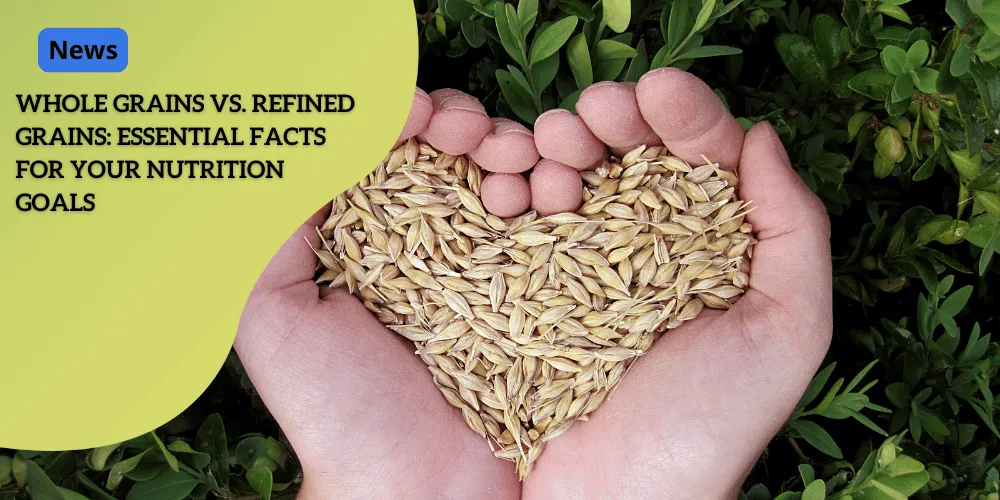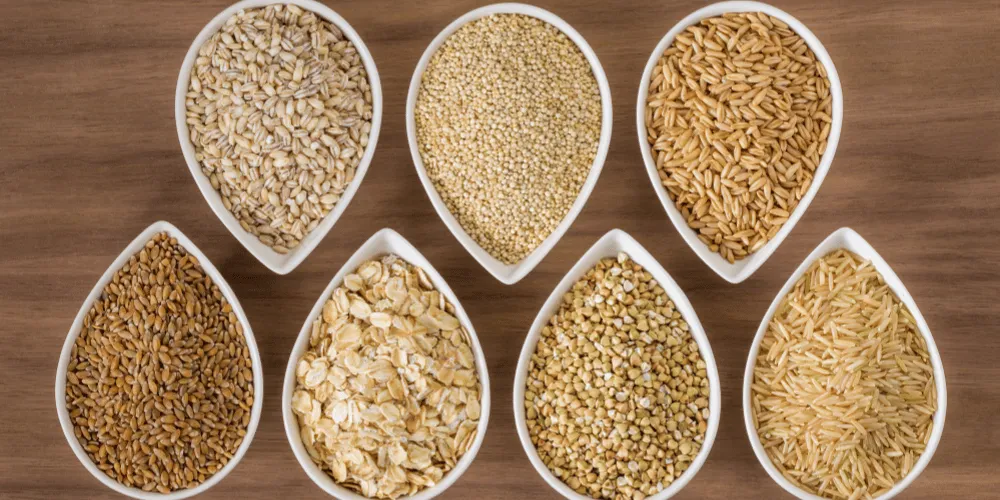Whole Grains vs. Refined Grains: Essential Facts for Your Nutrition Goals

Anúncios
Understanding Whole Grains vs. Refined Grains
When it comes to grains, understanding the difference between whole and refined grains is key to making healthier food choices.
This chapter will explore the critical distinctions and common types of whole grains accessible to you.
Anúncios
Whole Grains: Nutrient-Rich Components
Whole grains include the entire grain kernel: the bran, germ, and endosperm.
The bran is the fiber-rich outer layer that supplies B vitamins, iron, copper, zinc, magnesium, antioxidants, and phytochemicals.
Anúncios
The germ is the core that provides vitamins B and E, antioxidants, phytochemicals, and healthy fats.
The endosperm, which is the embryo’s food supply, provides primarily carbohydrates and some proteins.
Refined Grains: Stripped of Nutrients
Refined grains, on the other hand, are milled to remove the bran and germ.
This process extends the shelf life of grains but also strips away significant nutrients.
Refined grains like white rice and white bread lack much of the fiber, vitamins, and minerals found in their whole-grain counterparts.
Common Whole Grains
-
Oatmeal – A staple breakfast choice known for its cardiovascular benefits due to soluble fiber.
Whole Wheat Flour – Commonly used in baking, retaining the nutrient-rich components of the whole wheat kernel.
Farro – An ancient grain that is chewy and full of nutrients, often used in salads and soups.
Quinoa – A protein-packed seed that is a complete protein, meaning it contains all nine essential amino acids.
Barley – High in fiber and traditionally used in soups and stews to add a nutritious boost.
Various Types of Rice – Brown, black, red, and wild rice are examples that contain the entire grain, offering different flavors and nutrient profiles.
Each of these grains contributes uniquely to a balanced diet and can be incorporated into various meals throughout the day.
Transition to Nutritional Benefits
Recognizing the primary differences between whole and refined grains sets the stage for understanding their respective nutritional benefits.
The subsequent chapter will detail how whole grains can enhance overall health with their higher content of fiber, protein, and essential micronutrients.
Nutritional Benefits of Whole Grains
Higher Fiber, Protein, and Micronutrient Content
When comparing whole grains to their refined counterparts, the nutritional edge of whole grains is apparent.
This can largely be attributed to the fact that whole grains retain the nutrient-rich bran and germ components.
These components are packed with fiber, protein, and essential micronutrients such as B vitamins, iron, and antioxidants.
Refined grains, on the other hand, have these parts removed, significantly diminishing their nutritional value.
This key difference explains why whole grains are often the superior choice for a balanced diet.
More Filling and Nutritionally Balanced Options
Whole grains are not only more nutritious; they also have a more filling nature.
The higher fiber and protein content contribute to a prolonged sense of satiety.
This means that meals incorporating whole grains can help curb hunger more effectively than those made with refined grains.
Furthermore, the nutritional balance provided by whole grains supports more stable blood sugar levels and sustained energy throughout the day.
 Each grain has its own benefit
Each grain has its own benefit
Specific Benefits Vary by Grain Type
The health benefits of whole grains can vary significantly based on the type of grain consumed.
For instance:
Oats: Renowned for their cardiovascular benefits, oats contain beta-glucan, a type of soluble fiber that can help lower cholesterol levels.
Quinoa: This grain is a complete protein, providing all nine essential amino acids, making it an excellent choice for vegetarians and vegans.
Barley: High in both soluble and insoluble fiber, barley supports digestive health and has been linked to lowered blood sugar levels.
Farro: Rich in antioxidants, farro is another ancient grain that adds a distinct nutty flavor and numerous health benefits to meals.
By diversifying the types of whole grains included in your diet, you can take advantage of the unique health benefits each grain offers.
These nutritional advantages make it clear that whole grains should play a significant role in a healthy diet.
As we move forward in our exploration of incorporating these grains into our daily lives, we will see how practical choices and a personalized approach can make this transition seamless and enjoyable.
USDA Recommendations and Scientific Evidence
USDA Guidelines on Whole Grains
The United States Department of Agriculture (USDA) has clear advice when it comes to incorporating grains into your diet.
They recommend that at least half of your daily grain intake should consist of whole grains.
This is to ensure that you benefit from the comprehensive nutritional profile that whole grains offer, which includes fiber, proteins, and essential micronutrients, typically lacking in refined grains.
Scientific Research Supporting Whole Grains
Backing this USDA guideline is robust scientific evidence.
A comprehensive review published in 2019 in the journal Advances in Nutrition underscores the benefits of whole grain consumption.
The review consolidates numerous studies highlighting how whole grains contribute to better overall health outcomes.
For instance, whole grains like oats have been associated with improving cardiovascular health, while bulgur, a high-fiber option, is particularly beneficial for individuals with conditions like Celiac Disease.
The Case Against Reducing Refined Grains
Interestingly, while the push for more whole grains is strong, there isn’t significant evidence advocating for the reduction of refined grains.
The 2019 review found no substantial body of scientific evidence to suggest that eating a moderate amount of refined grains poses significant health risks.
It appears that the negative perception of refined grains often stems from confusing correlation with causation.
Therefore, while prioritizing whole grains is beneficial, it doesn’t mean you must entirely eliminate refined grains from your diet.
Balancing Whole and Refined Grains
A practical dietary approach is to ensure that about three-quarters of your grains are whole grains, as this strikes a favorable balance between nutrition and convenience.
Even though refined grains like white bread and white rice are often seen as less nutritious, they still possess valuable nutrients.
Additionally, refined grains can play a role in a varied and balanced diet without necessarily undermining health goals.
This flexibility underscores an important point: healthful eating must be adaptable to your personal needs—including your budget, cultural preferences, and specific health goals—rather than adhering strictly to one-size-fits-all guidelines.
This adaptability is crucial for maintaining a sustainable and practical approach to nutrition.
By understanding and implementing these balanced recommendations, you can make informed decisions that best suit your lifestyle and health objectives.
Practical Implementation in Diet
Transforming your grain choices can feel like a big step, but it doesn’t have to be overwhelming.
Here’s how to make practical changes to include more whole grains in your everyday meals while maintaining a balance between convenience and nutrition.
Aim for 3/4 of Grain Intake to Be Whole Grains
Instead of worrying about eliminating refined grains entirely, focus on making three-quarters of your grain intake come from whole grains.
This targeted approach ensures that you enjoy a rich diet full of diverse nutrients.
Simple Ways to Incorporate Whole Grains
You don’t need to make drastic changes to see benefits.
Here are a few easy swaps and additions:
Start with Breakfast: Choose oatmeal or a whole grain cereal for a fiber-rich start to your day.
Whole Grain Bread: Make your sandwiches using whole grain bread rather than white bread.
Side Dishes: Incorporate whole grains like barley or quinoa as a side dish for dinner.
They are easy to prepare and can be very delicious when seasoned well.
Snacks: Keep it simple with whole grain crackers and rice cakes for a quick snack time fix.
These adjustments can gradually build a preference for whole grains in your diet, making the transition smoother and more sustainable.
Balancing Nutrient-Dense Options with Convenience
Balance is key to maintaining a realistic and enjoyable diet.
While whole grains should be a primary choice due to their superior nutrient profile, allowing yourself convenience foods on occasion is perfectly acceptable.
For example:
Quick Lunches: If whole grain options aren’t available, a sandwich with white bread is still an acceptable choice.
Dining Out: It’s okay to enjoy white rice with your meal if whole grain options aren’t available.
Remember, the goal is to create long-term habits that can accommodate both nutritional goals and the realities of busy lifestyles.
Conclusion
The journey towards healthier eating with whole grains involves practical changes and maintaining flexibility.
By aiming to make most of your grains whole, gradually incorporating easy swaps, and remaining open to a balanced approach, you can achieve a diet that is both nutritious and flexible to your lifestyle needs.
Personalized Approach to Grain Choices
Consider Individual Factors
When it comes to choosing the right grains for your diet, there are a variety of personal factors to take into account.
Your budget, cultural preferences, and specific health goals all play an important role in shaping your diet.
Budget: Whole grains can sometimes be more expensive than refined grains, so it’s important to choose options that fit within your financial means. Bulk-buying grains like oatmeal, brown rice, and whole wheat flour can help save money.
Culture: Traditional diets are often based around certain types of grains. Incorporating whole grain versions of your cultural staples can be a great way to maintain your heritage while boosting your nutrition.
Health Goals: Different grains offer different health benefits. Oats are great for heart health, quinoa is a fantastic source of protein, and barley can aid digestion. Choose grains that align with your specific health objectives.
No One-Size-Fits-All Approach
Healthy eating is not a one-size-fits-all process. What’s “healthy” can be different for everyone based on their unique situations.
It’s unrealistic and unnecessary to strictly avoid refined grains altogether.
Moderation is key. The USDA recommends making half of your daily grain intake whole grains, but you can adapt this to fit your lifestyle.
Aim for around 3/4 of your grain intake to be whole grains to reap the nutritional benefits while still enjoying the convenience and taste of refined grains when needed.
Flexibility in Grain Choices
Adopt a flexible approach to incorporating whole grains into your diet.
It doesn’t have to be all or nothing.
Here are some practical tips:
Simple Swaps: Choose whole grain bread instead of white bread, and opt for whole grain pasta over traditional pasta.
Convenient Whole Grains: Instant oatmeal, pre-cooked brown rice, and whole grain crackers are quick and easy options to incorporate into your diet without much hassle.
Balanced Choices: Don’t stress about the occasional white rice or refined grain. Balancing your diet with mainly whole grains while allowing some refined grains can keep your meals enjoyable and less restrictive.
Remember, the best approach to a nutritious diet is one that you can sustain long-term, enjoys, and fits your lifestyle.
Embracing flexibility and mindful choices will help you meet your nutrition goals without feeling overwhelmed or deprived.






